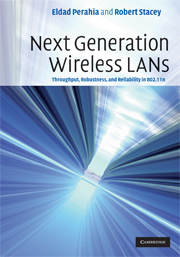Book contents
- Frontmatter
- Contents
- Foreword by Dr. Andrew Myles
- Preface
- List of abbreviations
- 1 Introduction
- Part I Physical layer
- Part II Medium access control layer
- 7 Medium access control
- 8 MAC throughput enhancements
- 9 Advanced channel access techniques
- 10 Interoperability and coexistence
- 11 MAC frame formats
- Part III Transmit beamforming
- Index
- References
10 - Interoperability and coexistence
from Part II - Medium access control layer
Published online by Cambridge University Press: 04 December 2009
- Frontmatter
- Contents
- Foreword by Dr. Andrew Myles
- Preface
- List of abbreviations
- 1 Introduction
- Part I Physical layer
- Part II Medium access control layer
- 7 Medium access control
- 8 MAC throughput enhancements
- 9 Advanced channel access techniques
- 10 Interoperability and coexistence
- 11 MAC frame formats
- Part III Transmit beamforming
- Index
- References
Summary
The 802.11n amendment, more so than any previous 802.11 amendment, introduces many optional features geared toward specific market segments that will likely only be deployed in specific classes of devices. Many of the optional features are complex and, given time to market concerns and cost constraints, many implementations will only adopt a subset of the available features, perhaps phasing in features with time or in higher end products. Some features appear in multiple flavors. This is due to the many unknowns present at the time the features where being discussed during the standard development process. Very often there was no single clear direction to take that would clearly suit all situations and so variations were introduced.
The popularity of 802.11 also means that there are a large number of legacy 802.11 devices deployed making interoperability and coexistence with those devices essential.
This chapter discusses various features that help ensure interoperability and coexistence between 802.11n compliant devices as well as legacy 802.11 devices.
Station and BSS capabilities
With the large number of optional features in the 802.11n amendment a fair bit of signaling is required to establish device capabilities and ensure interoperability. Also, care must be taken to ensure that a feature used by one station does not adversely affect the operation of a neighboring station that is not directly involved in the data frame exchange.
- Type
- Chapter
- Information
- Next Generation Wireless LANsThroughput, Robustness, and Reliability in 802.11n, pp. 238 - 265Publisher: Cambridge University PressPrint publication year: 2008



